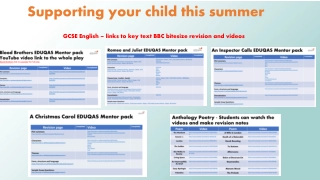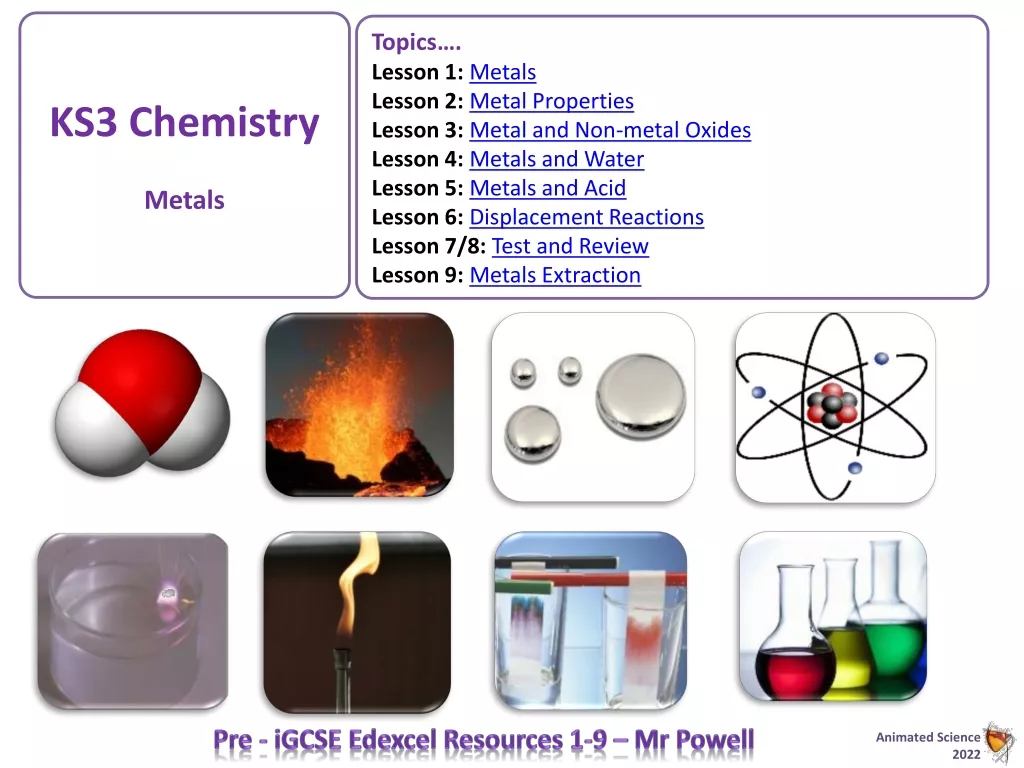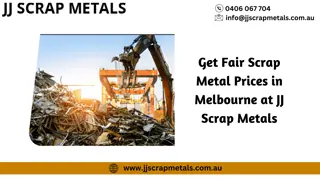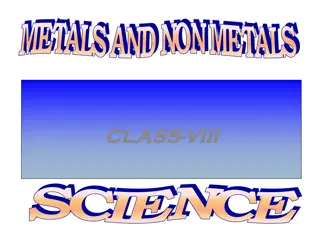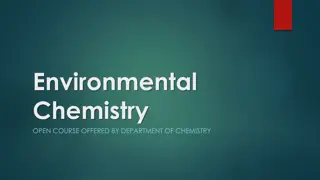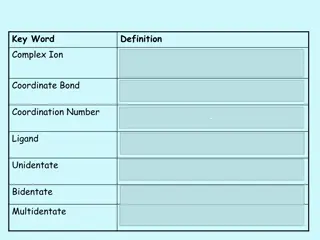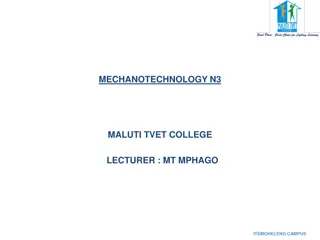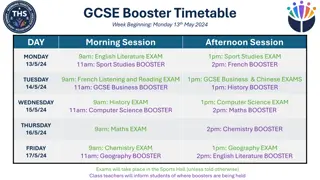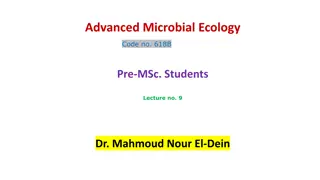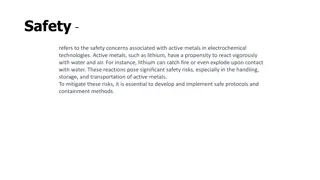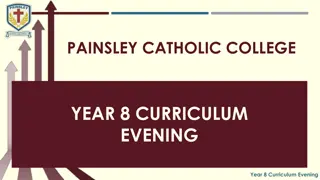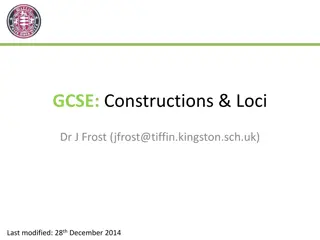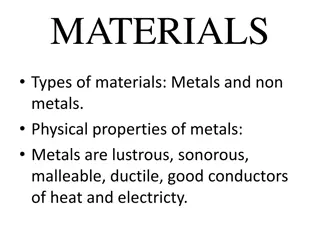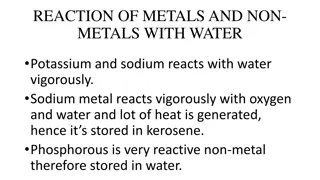Interactive GCSE Chemistry Lesson on Metals and Non-Metals
Engage in a dynamic one-hour lecture focusing on metals and non-metals in GCSE Chemistry. Discover the properties of metals and non-metals, understand the metallic bond, and explore the periodic table. Participate in tasks of varying difficulty levels, discuss statements related to metals and non-metals, and watch an informative video highlighting their properties. Enhance your understanding through interactive learning activities and stay safe by following distancing guidelines.
Download Presentation

Please find below an Image/Link to download the presentation.
The content on the website is provided AS IS for your information and personal use only. It may not be sold, licensed, or shared on other websites without obtaining consent from the author.If you encounter any issues during the download, it is possible that the publisher has removed the file from their server.
You are allowed to download the files provided on this website for personal or commercial use, subject to the condition that they are used lawfully. All files are the property of their respective owners.
The content on the website is provided AS IS for your information and personal use only. It may not be sold, licensed, or shared on other websites without obtaining consent from the author.
E N D
Presentation Transcript
Click and Teach GCSE CHEMISTRY TOPIC: METALS AND NON-METALS 1 hour lecture lesson You should have your book (or paper) and a pen
Aims of the lesson To know where to find metals and non-metals on the Periodic Table To know the properties of both metals and non-metals using the correct terms To understand the metallic bond To be able to apply knowledge of the metallic bond to explain some properties of metals In order to maintain social distancing and keep everyone safe: (a) You will need to copy from the board, rather than have worksheets (b) There will be EASY, MEDIUM or HARDER tasks for different abilities in the room (c) Put your hand up if you need some help, but don t leave your seat (d) Don t share equipment, and keep your work with you at the end of the lesson.
Think about the following statements: A C B 8 minutes Steel, brass and bronze are called metals so they should be on the Periodic Table All the elements of the Periodic Table are divided into metals and non- metals There are more metals than non- metals D All metals are magnetic Try and complete all 3 tasks if you can. 1) EASY: Copy each statement and say if it s true or false. 2) MEDIUM: Rewrite any statement you think is false to make it true. 3) HARD: Explain why you think each statement is true or false.
Discussion/answers: What did you think? A) Mainly true for KS4- although many scientists now classify the elements into metals, non-metals and metalloids (these can be found on either side of the staircase that separates metals from non-metals) B) True: metals found to the left of the staircase . About 70 metals compared to about 22 non-metal elements. C) False: Steel, brass and bronze are NOT elements, they are made up of mixtures of metals- called ALLOYS. D) False: You probably know that iron is magnetic but aluminium (eg used in drinks cans) is not. In fact, only iron, cobaltnd nickel are magnetic.
Watch this video about the properties of metals and non-metals https://www.youtube.com/watch?v=Rc2JBp91V7o Listen carefully as there will be some questions to follow!
QUICK TASK: using the symbols on the periodic table shown, can you name (a) a metal in group 1 (b) a non-metal in group 7 (c) two magnetic elements (d) the only liquid non- metal (e) the non-metal that conducts electricity? (f) the only liquid metal (g) an element that could form a positive 2+ ion (h) an element that could form a 2- ion The Period Table 5 minutes Just write the answers, no need to copy out the question!
Possible Answers! a) Li, Na, K b) F, Cl, Br, I c) Fe, Ni d) Br e) C f)Hg g) Be, Mg, Ca (also Fe, Cu, Zn, Ni) h) O, S How did you do?
Match the key term to its definition 5 minutes Malleable Shatters when bent or hit Can be drawn out into a wire without snapping Brittle Can be bent or hammered without shattering Ductile Sonorous Shiny Makes a ringing sound when hit Lustrous
Answers! Malleable Shatters when bent or hit Can be drawn out into a wire without snapping Brittle Can be bent or hammered without shattering Ductile Sonorous Shiny Makes a ringing sound when hit Lustrous
Copy and complete the table on the properties of metals and non-metals 10 minutes PROPERTY METALS NON-METALS Appearance State at room temperature Density Strength Malleable or brittle Conduction of heat Conduction of electricity Magnetic material Sound when hit When completed, check answers on next slide!
PROPERTY METALS NON-METALS Appearance Shiny Dull State at room temperature Solid (except mercury, which is a liquid) About half are solids, about half are gases, and one (bromine) is a liquid Density High (they feel heavy for their size) Low (they feel light for their size) Strength Strong Weak Malleable or brittle Malleable (bend without breaking) Brittle (break or shatter when hammered) Conduction of heat Good Poor (they are insulators) Conduction of electricity Good Poor (they are insulators, apart from graphite) Magnetic material Only iron, cobalt and nickel None Sound when hit They make a ringing sound (they are sonorous) They make a dull sound
Watch this video on metallic bonding https://www.youtube.com/watch?v=S08qdOTd0w0 This will help explain some of the properties that metals have! There will be some questions to follow
10 minutes METALLIC BONDING a) draw the diagram to show the bonding in metals Metal atoms are very closely packed together in a lattice structure. These atoms are held together by metallic bonds. b) COPY AND COMPLETE THE FOLLOWING- USE THE WORDS IN THE BOX BELOW In metals, the leave the outer shell of each metal atom forming metal . These electrons are . to move over the surface of the atoms and are called electrons. A metallic bond is the .. of attraction between the metal ions and the delocalised electrons. ELECTROSTATIC FORCE, DELOCALISED, FREE, POSITIVE, ELECTRONS, IONS EXTENSION: What is a lattice structure?
Answers! In metals, the electrons leave the outer shell of each metal atom forming positive metal ions These electrons are free to move over the surface of the atoms and are called delocalised electrons. A metallic bond is the electrostatic force of attraction between the metal ions and the delocalised electrons. EXTENSION: A lattice is a structure with a regular repeating pattern.
Answer the following three questions: 8 minutes Use your knowledge of metallic bonding to explain these properties of metals. Write out the questions and your answer. Attempt all questions if you can! a) Why are metallic bonds strong? EASY b) Why do metals have a high melting point? MEDIUM c) Why do metals conduct electricity? HARD
Answers! a) Metallic bonds are strong because there are STRONG attractions between the delocalised electrons and positive ions. b) Metals have high melting points because there are strong attractions between the delocalised electrons and positive ions. A LOT OF HEAT/ENERGY is needed to break the strong bonds. c) In order to conduct electricity there must be CHARGED particles which are FREE TO MOVE. Metals conduct electricity because there are delocalised electrons which can MOVE (and carry the charge).
Aims of the lesson- how did we do? To know where to find metals and non-metals on the Periodic Table To know the properties of both metals and non-metals using the correct terms To understand the metallic bond To be able to apply knowledge of the metallic bond to explain some properties of metals


